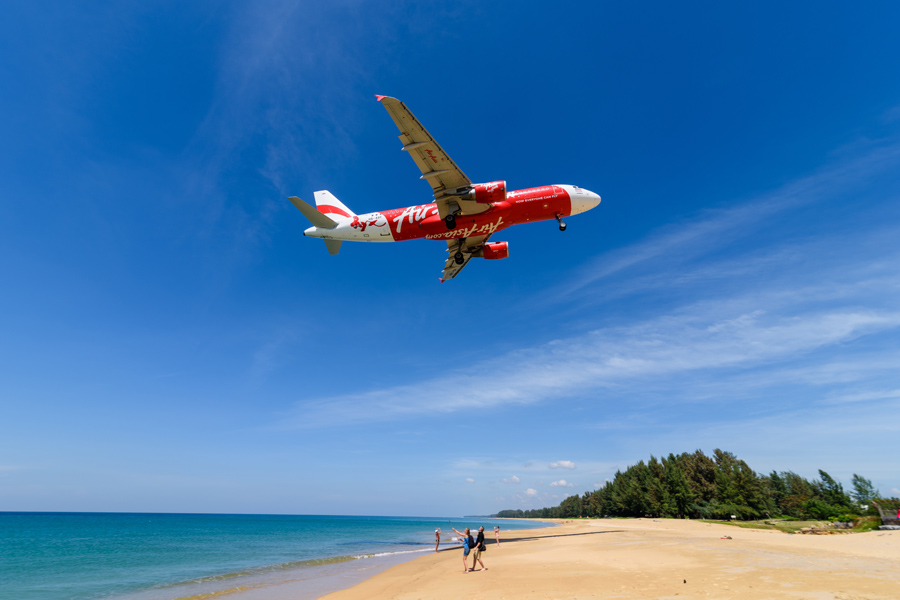Low cost carriers are a relatively new idea to Asia, with the early pioneers first taking off in the early 2000’s. Since then, there’s been a slew of budget airlines that have come – and gone – in the battle for intra-regional supremacy. The one I use the most frequently in the Asia Pacific is AirAsia for their extensive coverage of the region, which also extends to Europe, Australia, and other corners of the world, with no signs of stopping.
Transportation and accommodation are by far the bulk of all travel expenses, and I usually choose budget airlines to minimize the former so I can splash out on the latter. Unlike trains, flights definitely do not comply to the adage: ‘the joy is in the journey’. Sure, for last minute bookings, travellers are more often than not better off flying full frills, but with enough advanced planning, locking in travel dates across multiple cities, my wallet willingly lets me shell out to enjoy the destinations ‘sans reserve’ when I finally arrive.
The Man
Through an old family friend, I was able to meet Tassapon Bijleveld, the CEO of Thai AirAsia and had the opportunity to speak with him and see if there were new destinations in the pipeline I could take note for my next holiday. Joe (his nickname) did not look any bit like a CEO of a company that’s flown more than 100 million passengers since their first flight took to the skies in 2002. At the risk of sounding ageist, he was younger than I expected, a slim man that looked to be in his 40s, dressed in a polo shirt, and a ready grin not unlike that of an excited child in a candy shop. His accent was hard to place, not exclusively attributed to either his Thai nor his Dutch heritage, and he spoke fast, peppering his points with anecdotes and asking rhetorical questions.
Joe joined the company from the get-go, leaving his previous post as managing director at Warner Music Thailand, a stint he held for 5 years. When asked about the challenges he faces as the industry changes, he laughed and said that if one can manage an artist, it’s not difficult to manage anyone else. Judging by the difficult attitudes of quasi-celebrities that descend on the high-end club venues in Bangkok, I can only imagine the stories he must have. Diva’s apart, in 2010, the company carried 5.8 million passengers, which represented a 78% load factor.
The opportunity
He spoke of the opportunities in the Asia Pacific region, the only part of the world that boasted a double digit increase of 19% in 2010. If the region is just narrowed down to Southeast Asia, there are 680 million people that live there. If a fraction, say a tenth of that number wishes to fly, that adds up to numerous planes across several airlines required to serve the demand of 68 million airborne travelers. And because the Asia region is an attractive destination as a whole, offering a wide array of cultural and natural attractions, most tourists, myself included, tend to visit more that just one city in order to make the most of hard-to-come-by holiday time.
From Bangkok alone, AirAsia flies to 11 destinations in Thailand, something I took advantage of during my last visit, visiting the gentle capital of the north, Chiang Mai, as well as the gorgeous island destination of Phuket. On the same trip, I also spent some time in Bali, Penang, and Phnom Penh, and as previously mentioned, was happy to shell out for nice digs from the savings I made on budget tickets. Granted, staying right on the beach or having a masseuse work on my knots as I lay on the seaside pavilion isn’t going to make or break a trip, but I for one would be willing to sacrifice peanuts and fixed seating onboard a flight to attain such indulgences.
The expansion
Joe revealed plans to expand AirAsia’s destinations into China and India, both countries with massive tourist appeal, and he went on to explain that one of the main advantages of having a ‘small’ airline is that they can move fast on decisions. He gave the example of Phuket and Chiang Mai – a direct route between the two distinctly appealing destinations has never been established, but recognizing the opportunity, AirAsia launched what they called an untested ‘unique route’. The route, which saves on layover time in the capital, is now offered daily, a frequency they’re looking to increase with a 90% load factor as proof of popularity. It hasn’t all been smooth sailing, Joe revealed, citing the example of the closure of the Phuket to Ho Chi Minh route, which was shut down just 6 months after launching. He shrugged it off with a “Don’t be sentimental if something doesn’t work. It is not every time that we get to hit the jackpot.”
Joe is confident that his company will meet if not exceed their 2011 targets of 7 million passengers, numbers realized under the AirAsia’s mantra of ‘Now Everyone Can Fly’.
There’s no need to settle for standard accommodation just because air tickets are burning a hole in your pocket a size larger than you’d like. Below are low-cost carriers that offer a wide blanket of routes around the Asia Pacific region so you can stay in a private luxury villa – as surely you deserve:
- AirAsia: http://airasia.com
- Jetstar: http://jetstar.com
- Tiger Airways: http://tigerairways.com
- IndiGo: http://goindigo.in
- Cebu Pacific: http://cebupacificair.com

